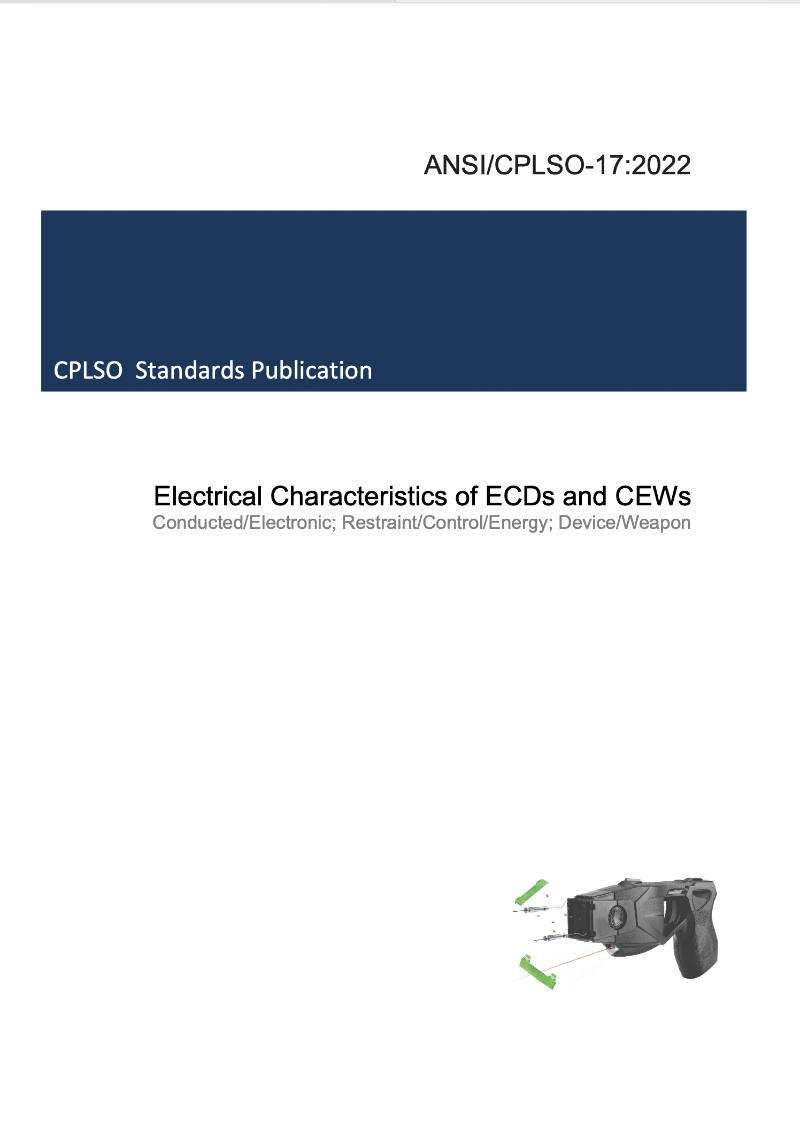Description
The Background
Electronic control with a conducted electrical weapon (CEW) has broad acceptance with law-enforcement as the preferred less-lethal force option due to its proven injury reduction compared to other control tools. Large prospective studies find subject injury rate reductions of about 65%.1,2 This is consistent with a 2/3 reduction in fatal police shootings where CEW usage is not overly restricted.3 A prospective study found that 5.4% of CEW uses clearly prevented the use of lethal force by police.4
The Research
To obtain significant motor-nerve mediated neuromuscular incapacitation there must be a probe separation of at least 30 cm (12 in) on the front of the body with present CEWs.5 CEWs with weaker outputs require a greater probe spread which may not be attainable in a sudden frontal attack. A weaker-output CEW could fail to stop a violent attack thus forcing a law-enforcement officer to transition to a firearm which often has fatal outcomes. Thus, minimum output limits are required for effectiveness. While generally not appreciated by the public, the primary safety risk is that of low outputs leading to a firearm fatality.
Most authorities agree that electrocution is a theoretical possibility with an extremely thin individual and a fully penetrating CEW probe directly over the heart.6,7 Based on the distribution of probe landings and body habitus, this risk has been estimated at about 1:2.5 million – 1: 3 million uses.6-8 A debate centers on whether this rare possibility has yet been demonstrated in an actual case. 9-11 Swine are 3 times as sensitive to electrical current as humans.12 The largest swine electrocuted by a CEW weighed 36 kg (79 lbs).13 The levels of dangerous electrical current scale with body mass just like any drug dosage and conservatively with the square root of body mass.14 Thus, the best evidence suggests that the risk of CEW electrocution is limited to humans with a body mass under 46 lbs. Nevertheless, it behooves us to establish output maximum limits that allow for effectiveness yet stay far away from allowing an electrocution risk.
The majority of published research has focused on the dominant manufacturer but that is now changing as competitors emerge.15-18 This increases the need for a standard that encapsulates the known effects and determinacies of CEWs.
The Standard
This standard incorporates the known bioelectrical science on the effects of pulse durations and charge for nerve and cardiac stimulation.19,20 This is then incorporated with the pulse rate to set upper and lower limits for aggregate currents among other critical factors.
The References:
1. Taylor B, Woods DJ. Injuries to officers and suspects in police use-of-force cases: A quasi-experimental evaluation. Police Quarterly. 2010;13(3):260-289.
2. MacDonald JM, Kaminski RJ, Smith MR. The effect of less-lethal weapons on injuries in police use-of-force events. Am J Public Health. 2009;99(12):2268-2274.
3. Ferdik FV, Kaminski RJ, Cooney MD, Sevigny EL. The Influence of Agency Policies on Conducted Energy Device Use and Police Use of Lethal Force. Police Quarterly. 2014:1098611114548098.
4. Eastman AL, Metzger JC, Pepe PE, et al. Conductive electrical devices: a prospective, population-based study of the medical safety of law enforcement use. The Journal of trauma. 2008;64(6):1567-1572.
5. Ho J, Dawes D, Miner J, Kunz S, Nelson R, Sweeney J. Conducted electrical weapon incapacitation during a goal-directed task as a function of probe spread. Forensic science, medicine, and pathology. 2012;8(4):358-366.
6. Panescu D, Kroll M, Brave M. Cardiac fibrillation risks with TASER conducted electrical weapons. Conf Proc IEEE EMBC. 2015;37:323-329.
7. Kroll MW, Lakkireddy D, Rahko PS, Panescu D. Ventricular fibrillation risk estimation for conducted electrical weapons: critical convolutions. Conf Proc IEEE EMBC. 2011;33:271-277.
8. Rahko PS. Evaluation of the skin-to-heart distance in the standing adult by two-dimensional echocardiography. J Am Soc Echocardiogr. 2008;21(6):761-764.
9. Kroll MW, Lakkireddy DR, Stone JR, Luceri RM. TASER electronic control devices and cardiac arrests: coincidental or causal? Supplement. Circulation. 2014;129(1):On Line Supplement.
10. Zipes DP. TASER Electronic Control Devices Can Cause Cardiac Arrest in Humans. Circulation. 2014;129(1):101-111.
11. Goudge S. The health effects of conducted energy weapons: The Expert Panel on the Medical and Physiological Impacts of Conducted Energy Weapons. Council of Canadian Academies. 2013:http://www.scienceadvice.ca/en/assessments/completed/cew.aspx.
12. Walcott GP, Kroll MW, Ideker RE. Ventricular fibrillation: are swine a sensitive species? Journal of interventional cardiac electrophysiology : an international journal of arrhythmias and pacing. 2015.
13. Valentino DJ, Walter RJ, Dennis AJ, et al. Taser X26 discharges in swine: ventricular rhythm capture is dependent on discharge vector. The Journal of trauma. 2008;65(6):1478-1485; discussion 1485-1477.
14. Geddes LA, Cabler P, Moore AG, Rosborough J, Tacker WA. Threshold 60-Hz current required for ventricular fibrillation in subjects of various body weights. IEEE transactions on bio-medical engineering. 1973;20(6):465-468.
15. Scherr C, de Carvalho AC, Belem LJ, et al. Cardiovascular effects of SPARK conducted electrical weapon in healthy subjects. Int J Cardiol. 2016;225:123-127.
16. Khaja A, Govindarajan G, McDaniel W, Flaker G. Cardiac safety of conducted electrical devices in pigs and their effect on pacemaker function. Am J Emerg Med. 2010.
17. McDaniel WC. Cardiac safety of the surface application of the stinger s200. Biomed Sci Instrum. 2008;44:349-354.
18. Esquivel AO, Dawe EJ, Sala-Mercado JA, Hammond RL, Bir CA. The physiologic effects of a conducted electrical weapon in swine. Ann Emerg Med. 2007;50(5):576-583.
19. Weiss G. Sur la possibilite’ de rendre comparable entre eux les appareils survant a l’excitation electrique. Arch Ital de Biol. 1901;35:413-446.
20. Irnich W. Georges Weiss’ fundamental law of electrostimulation is 100 years old. Pacing and clinical electrophysiology : PACE. 2002;25(2):245-248.




